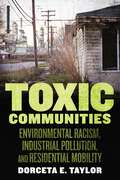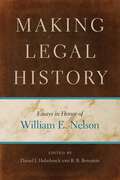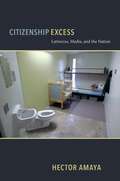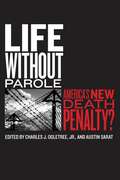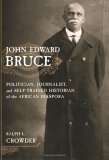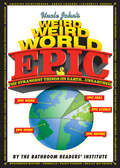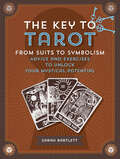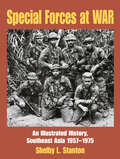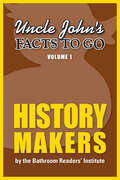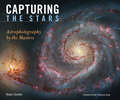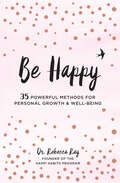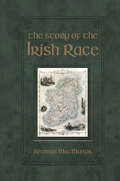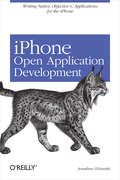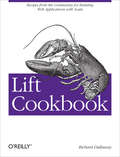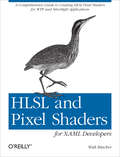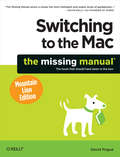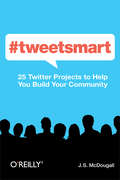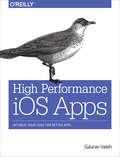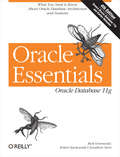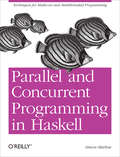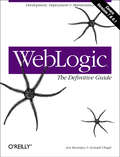- Table View
- List View
Toxic Communities: Environmental Racism, Industrial Pollution, and Residential Mobility
by Dorceta TaylorUncovers the systemic problems that expose poor communities to environmental hazardsFrom St. Louis to New Orleans, from Baltimore to Oklahoma City, there are poor and minority neighborhoods so beset by pollution that just living in them can be hazardous to your health. Due to entrenched segregation, zoning ordinances that privilege wealthier communities, or because businesses have found the ‘paths of least resistance,’ there are many hazardous waste and toxic facilities in these communities, leading residents to experience health and wellness problems on top of the race and class discrimination most already experience. Taking stock of the recent environmental justice scholarship, Toxic Communities examines the connections among residential segregation, zoning, and exposure to environmental hazards. Renowned environmental sociologist Dorceta Taylor focuses on the locations of hazardous facilities in low-income and minority communities and shows how they have been dumped on, contaminated and exposed.Drawing on an array of historical and contemporary case studies from across the country, Taylor explores controversies over racially-motivated decisions in zoning laws, eminent domain, government regulation (or lack thereof), and urban renewal. She provides a comprehensive overview of the debate over whether or not there is alink between environmental transgressions and discrimination, drawing a clear picture of the state of the environmental justice field today and where it is going. In doing so, she introduces new concepts and theories for understanding environmental racism that will be essential for environmental justice scholars. A fascinating landmark study, Toxic Communities greatly contributes to the study of race, the environment, and space in the contemporary United States.
Making Legal History: Essays in Honor of William E. Nelson
by William E. NelsonOne of the academy’s leading legal historians, William E. Nelson is the Edward Weinfeld Professor of Law at New York University School of Law. For more than four decades, Nelson has produced some of the most original and creative work on American constitutional and legal history. His prize-winning books have blazed new trails for historians with their substantive arguments and the scope and depth of Nelson’s exploration of primary sources. Nelson was the first legal scholar to use early American county court records as sources of legal and social history, and his work (on legal history in England, colonial America, and New York) has been a model for generations of legal historians. This book collects ten essays exemplifying and explaining the process of identifying and interpreting archival sources—the foundation of an array of methods of writing American legal history. The essays presented here span the full range of American history from the colonial era to the 1980s.Each historian has either identified a body of sources not previously explored or devised a new method of interrogating sources already known.The result is a kaleidoscopic examination of the historian’s task and of the research methods and interpretative strategies that characterize the rich, complex field of American constitutional and legal history.
Across the Divide: Union Soldiers View the Northern Home Front
by Steven J. RamoldUnionsoldiers left home in 1861 with expectations that the conflict would be short,the purpose of the war was clear, and public support back home was universal.As the war continued, however, Union soldiers began to perceive a greatdifference between what they expected and what was actually occurring. Theirfamily relationships were evolving, the purpose of the war was changing, andcivilians were questioning the leadership of the government and Army to thepoint of debating whether the war should continue at all.Separatedfrom Northern civilians by a series of literal and figurative divides, Unionsoldiers viewed the growing disparities between their own expectations andthose of their families at home with growing concern and alarm. Instead ofsupport for the war, an extensive and oft-violent anti-war movement emerged.Often at odds with those at home and with limited means of communication totheir homes at their disposal, soldiers used letters, newspaper editorials, andpolitical statements to influence the actions and beliefs of their homecommunities. When communication failed, soldiers sometimes took extremistpositions on the war, its conduct, and how civilian attitudes about theconflict should be shaped.In thisfirst study of the chasm between Union soldiers and northern civilians, Steven J.Ramold reveals the wide array of factors that prevented the Union Army and thecivilians on whose behalf they were fighting from becoming a united frontduring the Civil War. In Across theDivide, Ramold illustrates how the divided spheres of Civil War experiencecreated social and political conflict far removed from the better-knownbattlefields of the war.
Citizenship Excess: Latino/as, Media, and the Nation (Critical Cultural Communication #29)
by Hector Amaya“Drawing on the Athenian tradition of ‘wielding citizenship as a weapon to defend a contingently defined polis,’ Hector Amaya has crafted an elegant and sophisticated analysis of the contemporary policies designed to contain and criminalize Latina/os. Citizenship Excess demonstrates that he is one of the leading Latina/o Media Scholars today.” —Angharad N. Valdivia, General Editor of the International Encyclopedia of Media Studies and author of Latina/osDrawing on contemporary conflicts between Latino/as and anti-immigrant forces, Citizenship Excess illustrates the limitations of liberalism as expressed through U.S. media channels. Inspired by Latin American critical scholarship on the “coloniality of power,” Amaya demonstrates that nativists use the privileges associated with citizenship to accumulate power. That power is deployed to aggressively shape politics, culture, and the law, effectively undermining Latino/as who are marked by the ethno-racial and linguistic difference that nativists love to hate. Yet these social characteristics present crucial challenges to the political, legal, and cultural practices that define citizenship. Amaya examines the role of ethnicity and language in shaping the mediated public sphere through cases ranging from the participation of Latino/as in the Iraqi war and pro-immigration reform marches to labor laws restricting Latino/a participation in English-language media and news coverage of undocumented immigrant detention centers. Citizenship Excess demonstrates that the evolution of the idea of citizenship in the United States and the political and cultural practices that define it are intricately intertwined with nativism.
Life without Parole: America's New Death Penalty? (The Charles Hamilton Houston Institute Series on Race and Justice #1)
by Charles J. Ogletree Jr. Austin SaratIs life without parole the perfect compromise to the death penalty? Or is it as ethically fraught as capital punishment? This comprehensive, interdisciplinary anthology treats life without parole as “the new death penalty.” Editors Charles J. Ogletree, Jr. and Austin Sarat bring together original work by prominent scholars in an effort to better understand the growth of life without parole and its social, cultural, political, and legal meanings. What justifies the turn to life imprisonment? How should we understand the fact that this penalty is used disproportionately against racial minorities? What are the most promising avenues for limiting, reforming, or eliminating life without parole sentences in the United States? Contributors explore the structure of life without parole sentences and the impact they have on prisoners, where the penalty fits in modern theories of punishment, and prospects for (as well as challenges to) reform.
John Edward Bruce: Politician, Journalist, and Self-Trained Historian of the African Diaspora
by Ralph CrowderJohn Edward Bruce, a premier black journalist from the late 1800's until his death in 1924, was a vital force in the popularization of African American history. "Bruce Grit," as he was called, wrote for such publications as Marcus Garvey's nationalist newspaper, The Negro World, and McGirt's Magazine. Born a slave in Maryland in 1856, Bruce gained his freedom by joining a regiment of Union soldiers passing through on their way to Washington, DC. Bruce was in contact with major figures in African American history, including Henry Highland Garnett and Martin Delany, both instrumental in the development of 19th century Black nationalism and the struggle for Black liberation. Close relationships with Liberian statesman Edward Wilmot Blyden and with Alexander Crummell, a key advocate for the emigration of Blacks to Africa, assisted in Bruce's development into a leading African American spokesman. In 1911, Arthur Alfonso Schomburg and Bruce co-founded the Negro Society for Historical Research, which greatly influenced black book collecting and preservation as well as the study of African American themes.
Uncle John's Weird Weird World Epic: Epic (The Strangest Things on Earth... Unearthed
by Bathroom Readers' InstituteA collection of some of the wildest and weirdest trivia packed with incredible facts, obscure history, interesting origins, bizarre quotes, and more. The second fully illustrated entry in Uncle John&’s popular new Weird, Weird World series opens a portal to the bizarre. It&’s page after page of unbelievable history, odd origins, tales of amazing luck, kooky conspiracy theories, epic fails, astounding facts, and some things that are so weird that they defy description. That&’s where the pictures come in: Hundreds of eye-popping photographs and illustrations take the humor and the fun to a whole new dimension . . . to the EPIC zone! Read about . . . • How to Hypnotize a Chicken • The Origin of the Lie Detector • Weirdest Ways to Die at National Parks • Feral Cat Day and Other Strange-But-Real Holidays • Here Comes the Spammobile! • Keith Urban Legends • The Power of Poo • Winners of &“Ugly Dog&” Contests • Weird World Records • TV Shows That Were All a Dream • Kalshnikov Pat & the Helicopter Jailbreakers • Odd-phrodisiacs • Japan&’s Most Surreal Video Games • News Pundits Gone Wild • The Pacific Garbage Patch • Calamity Jane and the Old West&’s Toughest Gals • What Your Nose Says About Your Love Life • Scams That Could Only Be Pulled Off by Identical Twins • Anarchy in the E.R. And much, much more
Freak Weather: Stories (Grace Paley Prize in Short Fiction)
by Mary KurylaFrom a nurse who sees a rattlesnake in the pediatric ICU to an animal control officer convinced she's found her abducted daughter in the house of a dog hoarder, the thirteen stories in Freak Weather are as unpredictable as the atmospheric changes that give this collection its name. With dark and raucous humor, Mary Kuryla creates female characters who, at times, combine a violent urgency with lack of introspection as they struggle to get out from under the thumb of a perceived authority. The intricate language is inseparable from the narrator's conviction; the characters lie with such bravado they're soon tangled up in their own webs. This brand of romanticism in a female character is little tolerated, and Freak Weather's mission—Kuryla's artistic mission overall—is to scratch at the intolerable. Call it bad instructions for moral behavior.
The Key to Tarot: Advice and Exercises to Unlock Your Mystical Potential
by Sarah BartlettUnlock your own innate psychic potential with this guide to the art of Tarot.The Tarot can help you to make crucial decisions, confirm your true desires for the future, and enhance self-understanding.Perfect for beginner and intermediate Tarot enthusiasts, The Key to Tarot provides an overview of Tarot and uses a combination of detailed background information and fun, simple lessons and exercises to help build your skills.Learn all there is to know about reading and interpreting the seventy-eight cards in a Tarot deck and using them for the benefit of yourself and others.In addition, each of the book’s four main sections concludes with a specially designed “masterclass” that takes you to a deeper level of understanding, if you feel ready to do so.
Special Forces at War: An Illustrated History, Southeast Asia 1957–1975
by Shelby L. Stanton“A rare insider’s experience paired with a scholarly historical approach, making it an essential standout for any military library.” —Midwest Book ReviewMore than 8.7 million Americans reported for military duty in Southeast Asia, but only a select few wore the Green Beret, the distinctive symbol of the U.S. Army Special Forces. These elite soldiers played a crucial role during the protracted conflict.Special Forces at War: an Illustrated History, Southeast Asia 1957–1975 by wartime veteran and military historian Shelby L. Stanton shows Special Forces’ activity from the first deployments of Green Berets into battle, through their training, wartime advisory, border surveillance, strike force, and special operations roles.Unprecedented in scope, this photographic history features rare and unpublished images, providing an exclusive, insider view of covert activities such as Project Delta, whose Special Forces-trained Vietnamese commandos posed as North Vietnamese Army or Viet Cong troops behind communist lines. It depicts Special Forces’ camps before, during, and after enemy assaults. It features an array of lethal weapons used by resourceful Green Berets fighting to preserve their remote outposts, as well as allied and enemy documents and propaganda. From ordinary camp life to special missions, no aspect of Special Forces activities during the Second Indochina War has been overlooked.Stanton knows his subject first hand. During six years of active duty as an infantry officer in the U.S. Army, he served as a paratrooper platoon leader, an airborne ranger advisor to the Royal Thai Army Special Warfare Center, and a Special Forces long-range reconnaissance team commander in Southeast Asia before being wounded in combat in Nam Yu, Laos.
Uncle John's Facts to Go: History Makers (Facts to Go #1)
by Bathroom Readers' InstituteUncle John takes readers on a journey through the ages, shedding new light onto some of the past’s most famous (and infamous) figures, and digging up obscure history you’d never learn in school. Featuring classic BRI articles along with some great all-new material, History Makers travels from the Far East to the Old West, from ancient times to the recent past, debunking myths and exposing the truth along the way. So wind up your wayback machine and read all about…- The lost “Cloud People” of Peru - Twelve countries that no longer exist- Looney English Lords- The mystery of Great Zimbabwe’s ruins- What happens when a U.S. president goes bonkers- The strange fate of some famous body parts- History’s most hilarious blunders- Building the Great Wall(s) of China- Some startling predictions that didn’t pan out…and some that didAnd much, much more!
The Dictionary of Dreams: Every Meaning Interpreted (Complete Illustrated Encyclopedia Ser. #2)
by Quarto Publishing GroupOne of the most definitive books on the subject with more than 15,000 dream symbols to help you decode the meanings behind your nightly musings.The Dictionary of Dreams provides the necessary tools to interpret almost every dream object and its hidden meaning to better understand what your subconscious is telling you.Dreams can be fun and adventurous, but also frightening and distorted, and still again, they can be an endless combination of both. From spitting teeth out (a sign of aging), to creepy, crawly spiders (a sign that one feels like an outsider), dreams can mean much more to us once we learn how to decipher their hidden meanings. Whether positive or negative, The Dictionary of Dreamsgives you all the tools, symbols, and their true meanings to translate our cryptic nightly images.Starting with selections from classic texts like Interpretation of Dreams by Sigmund Freud, the father of psychoanalysis, and 10,000 Dreams Interpreted by Gustavus Hindman Miller, one of the first authors to complete a thorough study of all the symbols that appear in our dream-scape, this updated edition features revisions (such as the addition of cell phones, computers, televisions, and more) of Miller’s original interpretations to bring the book up to speed with our modern life.
Capturing the Stars: Astrophotography by the Masters
by Robert GendlerPortraits of the deep sky and of local astronomical phenomena taken by the world&’s renowned astrophotographers—with a foreword by Neil deGrasse Tyson. To gaze at the stars is one thing; to capture that gaze in photographs is something else, a tantalizing scientific art that many attempt and few master. That rare mastery is on full display in this beautiful volume of space photography from thirty of the most accomplished astrophotographers in the world, both professional and amateur. Galaxies, star clusters, nebulae, and other deep-sky treasures fill the pages. Along with the marvels of the night sky—the Andromeda and Whirlpool galaxies, the Pleiades and the Praesepe, the Orion and Crab nebulae, and many more—each section features a profile of the photographer&’s work, techniques, philosophy, and experiences. Compiled by the world&’s leading amateur astrophotographer, with an introduction to the history of space photography, this spectacular volume is an essential for every stargazer&’s bookshelf.elf.
Be Happy: 35 Powerful Methods for Personal Growth & Well-Being (Live Well Ser. #14)
by Rebecca RayA practical guide for forming thirty-five daily habits that will lead to a life of thriving rather than just surviving.You’ve heard it all before: Just think positive! Just believe! But there’s no quick fix for a happy life. Let Dr. Rebecca Ray guide you through the four central tenets of Choosing, Cultivating, Practicing, and Making Space for the good things in your world:Choosing to focus on life’s joys instead of its hardships.Cultivating a positive inner voice instead of always criticizing yourself.Practicing mindful productivity instead of multitasking overload.Making Space for crises instead of shutting down when things get tough.Be Happy’s techniques are based on the science of Positive Psychology and Acceptance and Commitment Therapy, the very movements responsible for millions of people improving their well-being. Become a happier version of yourself by adjusting your daily routine with these powerful tools!There is no set of habits more important than those that help you thrive—and because Be Happy’s tools are quick, simple, and enjoyable to use—integrating this book into your daily life is easy. Happiness is an emotional state that can be hard to find and hard to hold onto. By using these tools in your daily life, you can gain control over this fickle state and take your ability to thrive into your own hands.
The Story of the Irish Race: A Popular History Of Ireland
by Seumas MacManusThe classic popular history of Ireland—its rich past, legends, religious and political life, culture, and contributions to the wider world.In The Story of the Irish Race, popular storyteller Seumas MacManus provides a wide-ranging look at the development of Ireland and its people. Beginning with the early colonization by the Milesius of Spain, MacManus explores ancient stories about the Tuatha De Danann; Cuchullain; Fionn and the Fian; Irish invasions of Britain; St. Bridget and St. Patrick; the Vikings in Ireland; Irish missionaries and scholars abroad; and life and culture in ancient and medieval Ireland. He also investigates more recent events and names in Irish history, such as Oliver Cromwell, “The Wild Geese,” Wolfe Tone, Daniel O’Connell, the Fenians, the Famine, Charles Stewart Parnell, and the Land League. From its earliest days to the Easter Rising, MacManus provides an entertaining and enlightening look at one of the world’s most fascinating cultures.
iPhone Open Application Development: Write Native Objective-C Applications for the iPhone
by Jonathan ZdziarskiCertain technologies bring out everyone's hidden geek, and iPhone did the moment it was released. Even though Apple created iPhone as a closed device, tens of thousands of developers bought them with the express purpose of designing and running third-party software. In this clear and concise book, veteran hacker Jonathan Zdziarski -- one of the original hackers of the iPhone -- explains the iPhone's native environment and how you can build software for this device using its Objective-C, C, and C++ development frameworks.iPhone Open Application Development walks you through the iPhone's native development environment, offers an overview of the Objective-C language you'll use with it, and supplies background for the iPhone operating system. You also get detailed recipes and working examples for everyone's favorite iPhone features -- graphics and audio programming, interfaces for adding multitouch functionality to games, the use of hardware sensors, and the device's vast user interface kit.This book explains:How to access the iPhone's underlying operating systemThe makeup of an iPhone applicationHow to get the open source tool chain running on your desktopThe iPhone's core user interface framework, which is heavily tied to major application-level functionsUsing the many touted iPhone features such as multitouch, hardware sensors, and gesturesIntercepting and handling event notifications for many iPhone-related eventsRaw video surfaces and 3D transformations that take you deeper into advanced graphics on the iPhoneHow to record and play simple sounds and intercept sound eventsAdvanced digital audio output using Apple's new Audio Toolbox frameworkAdvanced user interface components such as section lists, keyboards, and image manipulationThe Appendix includes a compendium of miscellaneous code examples for cool application features, such as using the camera and creating a CoverFlow®-like album browser.This book is a true hacker's book, designed for the millions of users who have run third party applications on their iPhone, but its concepts and code examples have shown to be remarkably similar to Apple's official SDK, making this book a valuable resource for both camps. Any programmer can use this book to write applications with the same spectacular effects that made the device an immediate hit, and impress users just as much as the official iPhone software does. That programmer can easily be you.
Programming F# 3.0: A Comprehensive Guide for Writing Simple Code to Solve Complex Problems
by Chris SmithWhy learn F#? With this guide, you’ll learn how this multi-paradigm language not only offers you an enormous productivity boost through functional programming, but also lets you develop applications using your existing object-oriented and imperative programming skills. You’ll quickly discover the many advantages of the language, including access to all the great tools and libraries of the .NET platform.Reap the benefits of functional programming for your next project, whether you’re writing concurrent code, or building data- or math-intensive applications. With this comprehensive book, former F# team member Chris Smith gives you a head start on the fundamentals and walks you through advanced concepts of the F# language.Learn F#’s unique characteristics for building applicationsGain a solid understanding of F#’s core syntax, including object-oriented and imperative stylesMake your object-oriented code better by applying functional programming patternsUse advanced functional techniques, such as tail-recursion and computation expressionsTake advantage of multi-core processors with asynchronous workflows and parallel programmingUse new type providers for interacting with web services and information-rich environmentsLearn how well F# works as a scripting language
Lift Cookbook: Recipes from the Community for Building Web Applications with Scala
by Richard DallawayIf you need help building web applications with the Lift framework, this cookbook provides scores of concise, ready-to-use code solutions. You’ll find recipes for everything from setting up a coding environment to creating REST web services and deploying your application to production.Built on top of the Scala JVM programming language, Lift takes a different—yet ultimately easier—approach to development than MVC frameworks such as Rails. Each recipe in this book includes a discussion of how and why each solution works, not only to help you complete the task at hand, but also to illustrate how Lift works.Set up an environment and run your first Lift applicationGenerate HTML, using Lift’s View First approachSubmit forms and work with form elementsBuild REST web services with the framework’s RestHelper traitTake advantage of Lift’s support for Ajax and CometGet examples for modifying Lift’s request pipelineConvert Scala classes into tables, rows, and columns in a relational databaseSend email, call URLs, and schedule tasks from your applicationPackage and deploy your application to various hosted services
HLSL and Pixel Shaders for XAML Developers: A Comprehensive Guide to Creating HLSL Pixel Shaders for WPF and Silverlight Applications
by Walt RitscherPixel shaders are some of the more powerful graphic tools available for XAML programmers, but shader development bears little resemblance to traditional .NET programming. With this hands-on book, you’ll not only discover how to use existing shaders in your Windows Presentation Foundation (WPF) and Silverlight applications, you’ll also learn how create your own effects with XAML and Microsoft’s HLSL shading language.In the process, you’ll write, compile, and test custom XAML shaders with the Shazzam Shader Editor, a free utility developed by author Walt Ritscher. The book includes XAML and C# sample code, and Shazzam contains all of the sample shaders discussed.Learn how shaders help you extend the GPU’s rendering capabilitiesExplore prevailing shader types, such as color modification, blurring, and spatial transformationGet a quick tour of the shader features, and use pre-built effects on image elements in your applicationExamine the XAML ShaderEffect class to understand how WPF and Silverlight use shadersLearn about the shader-specific tools available in Visual Studio and Expression BlendGet up to speed on HLSL basics and learn how to create a variety of graphics effects
Switching to the Mac: The Missing Manual, Mountain Lion Edition
by David PogueReady to move to the Mac? This incomparable guide helps you make a smooth transition. New York Times columnist and Missing Manuals creator David Pogue gets you past three challenges: transferring your stuff, assembling Mac programs so you can do what you did with Windows, and learning your way around OS X.Learning to use a Mac is not a piece of cake, but once you do, the rewards are oh-so-much better. You won't find questionable firewalls or inefficient permissions. Just a beautiful machine with a thoroughly reliable system. Whether you’re using Windows XP or Windows 7, we’ve got you covered.Transfer your stuff. Moving files from a PC to a Mac is the easy part. This guide gets you through the tricky things: extracting your email, address book, calendar, Web bookmarks, buddy list, desktop pictures, and MP3 files.Re-create your software suite. Big-name programs from Microsoft, Adobe, and others are available in both Mac and Windows versions, but hundreds of other programs are Windows-only. Learn the Macintosh equivalents and how to move data to them.Learn OS X Mountain Lion. Once you’ve moved into the Macintosh mansion, it’s time to learn your way around. You’re in good hands with the author of Mac OS X: The Missing Manual, the #1 bestselling guide to OS X.
#tweetsmart: 25 Twitter Projects to Help You Build Your Community
by J. S. McDougall"OK. I’ve got my Twitter account…now what can I do with it?" Sound familiar? #tweetsmart provides the answer with 25 creative projects to help your business, cause, or organization grow. But this isn’t just another social media marketing book—it’s the anti-marketing how-to community-engagement book.Twitter is not a marketing channel (and should never be used as such) but it is a community of interested, engaged, and influential people. Meeting and getting to know these people can help you build your own community. In this useful guide, you’ll find projects to help you approach your Twitter audience in ways that are strategic, measurable, and fun.Put a new wrinkle on an old contest: "be the 10th person to tweet"Create a hashtag game around your company or productsInstead of polling, ask your followers to help you make a product decisionMake MadLibs out of your marketing copy or mission statementHold a scavenger hunt, and relay clues via TwitterOrganize a weekly Twitter chat on various subjectsSolicit funny product shots, using Twitter’s photo-sharing utilitySpontaneously tweet from a store location: "Meet me now and win!"
High Performance iOS Apps: Optimize Your Code for Better Apps
by Gaurav VaishReady to build mobile apps that out-perform the rest? If you’re an iOS developer with app-building experience, this practical guide provides tips and best practices to help you solve many common performance issues. You’ll learn how to design and optimize iOS apps that deliver a smooth experience even when the network is poor and memory is low.Today’s picky users want fast and responsive apps that don’t hog resources. In this book, author Gaurav Vaish demonstrates methods for writing optimal code from an engineering perspective, using reusable Objective-C code that you can use right away. Up your game and create high-performance native iOS apps that truly stand out from the crowd.Measure key performance indicators—attributes that constitute and affect app performanceWrite efficient apps by minimizing memory and power consumption, and explore options for using available CPU coresOptimize your app’s lifecycle and UI, as well as its networking, data sharing, and security featuresLearn about application testing, debugging and analysis tools, and monitoring your app in the wildCollect data from real users to analyze app usage, identify bottlenecks, and provide fixesUse iOS 9 upgrades to improve your app’s performance
Oracle Essentials: Oracle Database 11g
by Rick Greenwald Robert Stackowiak Jonathan SternOracle is an enormous system, with myriad technologies, options, and releases. Most users--even experienced developers and database administrators--find it difficult to get a handle on the full scope of the Oracle database. And, as each new Oracle version is released, users find themselves under increasing pressure to learn about a whole range of new technologies. The latest challenge is Oracle Database 11g.This book distills an enormous amount of information about Oracle into a compact, easy-to-read volume filled with focused text, illustrations, and helpful hints. It contains chapters on:Oracle products, options, data structures, and overall architecture for Oracle Database 11g, as well as earlier releases (Oracle Database 10g, Oracle9i, and Oracle8i)Installing, running, managing, monitoring, networking, and tuning Oracle, including Enterprise Manager (EM) and Oracle's self-tuning and management capabilities; and using Oracle security, auditing, and compliance (a new chapter in this edition)Multiuser concurrency, data warehouses, distributed databases, online transaction processing (OLTP), high availability, and hardware architectures (e.g., SMP, clusters, NUMA, and grid computing)Features beyond the Oracle database: Oracle Application Express, Fusion Middleware (including Oracle Application Server), and database SOA support as a Web services providerThe latest Oracle Database 11g features: query result set caching, Automatic Memory Management, the Real Application Testing, Advanced Compression, Total Recall, and Active Data Guard Option Options, changes to the OLAP Option (transparently accessed and managed as materialized views), the Flashback transaction command, transparent data encryption, the Support Workbench (and diagnosability infrastructure), and partitioning enhancements (including interval and new composite types)For new Oracle users, DBAs, developers, and managers, Oracle Essentials provides an invaluable, all-in-one introduction to the full range of Oracle features and technologies, including the just-released Oracle Database 11g features. But even if you already have a library full of Oracle documentation, you'll find that this compact book is the one you turn to, again and again, as your one-stop, truly essential reference."Oracle Essentials gives a clear explanation of the key database concepts and architecture underlying the Oracle database. It's a great reference for anyone doing development or management of Oracle databases."--Andrew Mendelsohn, Senior Vice President, Database Server Technologies, Oracle Corporation
Parallel and Concurrent Programming in Haskell: Techniques for Multicore and Multithreaded Programming
by Simon MarlowIf you have a working knowledge of Haskell, this hands-on book shows you how to use the language’s many APIs and frameworks for writing both parallel and concurrent programs. You’ll learn how parallelism exploits multicore processors to speed up computation-heavy programs, and how concurrency enables you to write programs with threads for multiple interactions.Author Simon Marlow walks you through the process with lots of code examples that you can run, experiment with, and extend. Divided into separate sections on Parallel and Concurrent Haskell, this book also includes exercises to help you become familiar with the concepts presented:Express parallelism in Haskell with the Eval monad and Evaluation StrategiesParallelize ordinary Haskell code with the Par monadBuild parallel array-based computations, using the Repa libraryUse the Accelerate library to run computations directly on the GPUWork with basic interfaces for writing concurrent codeBuild trees of threads for larger and more complex programsLearn how to build high-speed concurrent network serversWrite distributed programs that run on multiple machines in a network
WebLogic: Development, Deployment & Maintenance
by Avinash Chugh Jon MountjoyBEA's WebLogic Server implements the full range of J2EE technologies, and includes many additional features such as advanced management, clustering, and web services. Widely adopted, it forms the core of the WebLogic platform, providing a stable framework for building scalable, highly available, and secure applications. In fact, in the long list of WebLogic's strengths and features, only one shortcoming stands out: the documentation that comes with the WebLogic server often leaves users clamoring for more information.WebLogic: The Definitive Guide presents a 360-degree view of the world of WebLogic. Providing in-depth coverage of the WebLogic server, the book takes the concept of "definitive" to a whole new level. Exhaustive treatment of the WebLogic server and management console answers any question that developers or administrators might think to ask. Developers will find a useful guide through the world of WebLogic to help them apply their J2EE expertise to build and manage applications. Administrators will discover all they need to manage a WebLogic-based setup. And system architects will appreciate the detailed analysis of the different system architectures supported by WebLogic, the overall organization of a WebLogic domain and supporting network infrastructure, and more.WebLogic: The Definitive Guide is divided into three sections that explore WebLogic and J2EE, Managing the WebLogic Environment, and WebLogic Enterprise APIs. Some of the topics covered in this comprehensive volume include:Building web applications on the WebLogic ServerBuilding and optimizing RMI applicationsUsing EJBs with WebLogic, including CMP entity beansPackaging and deploying applicationsUnderstanding WebLogic's support for clusteringPerformance tuning and related configuration settingsConfiguring WebLogic's SSL supportMaximizing WebLogic's security featuresBuilding web services with XMLUsing WebLogic's JMX services and MBeansAnyone who has struggled with mastering the WebLogic server will appreciate the thorough, clearly written explanations and examples in this book. WebLogic: The Definitive Guide is the definitive documentation for this popular J2EE application server.
